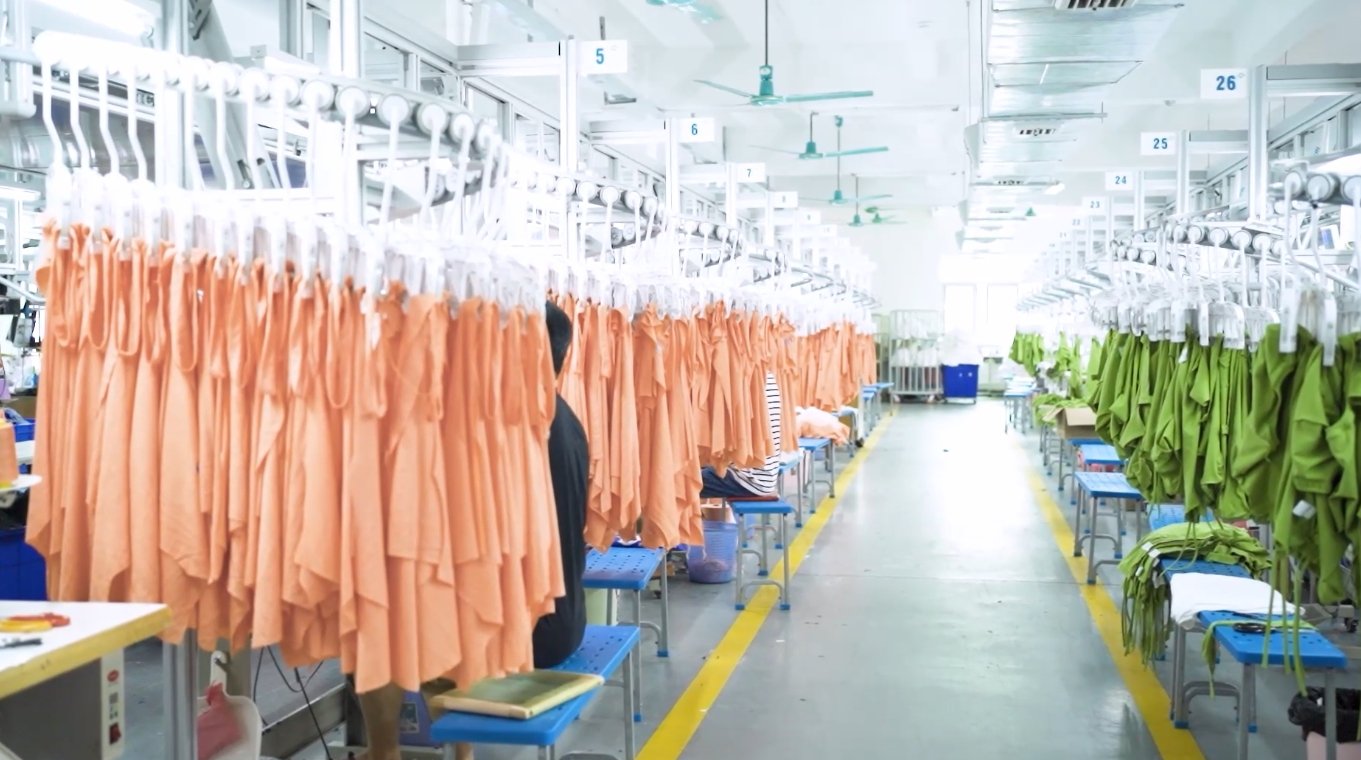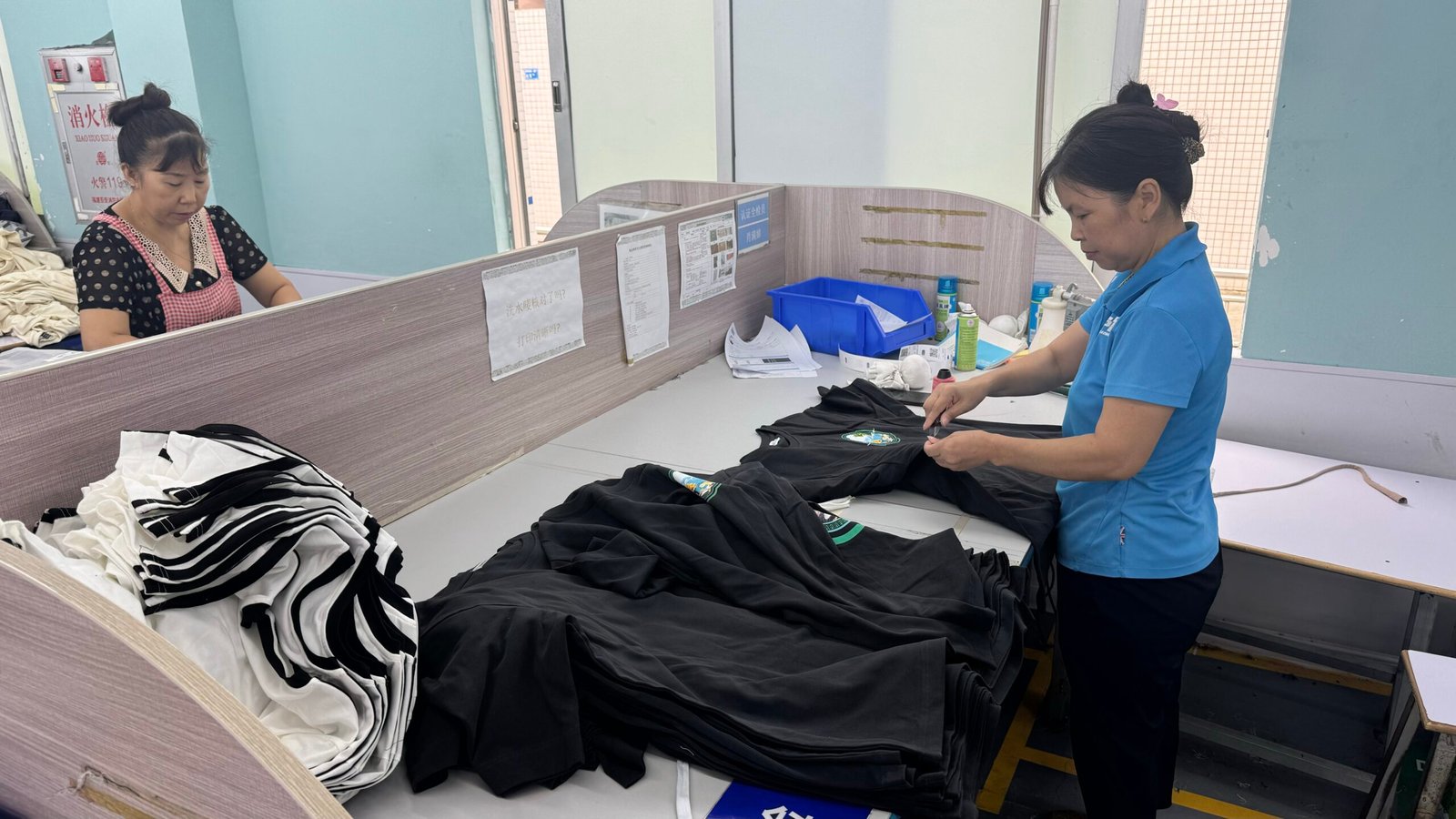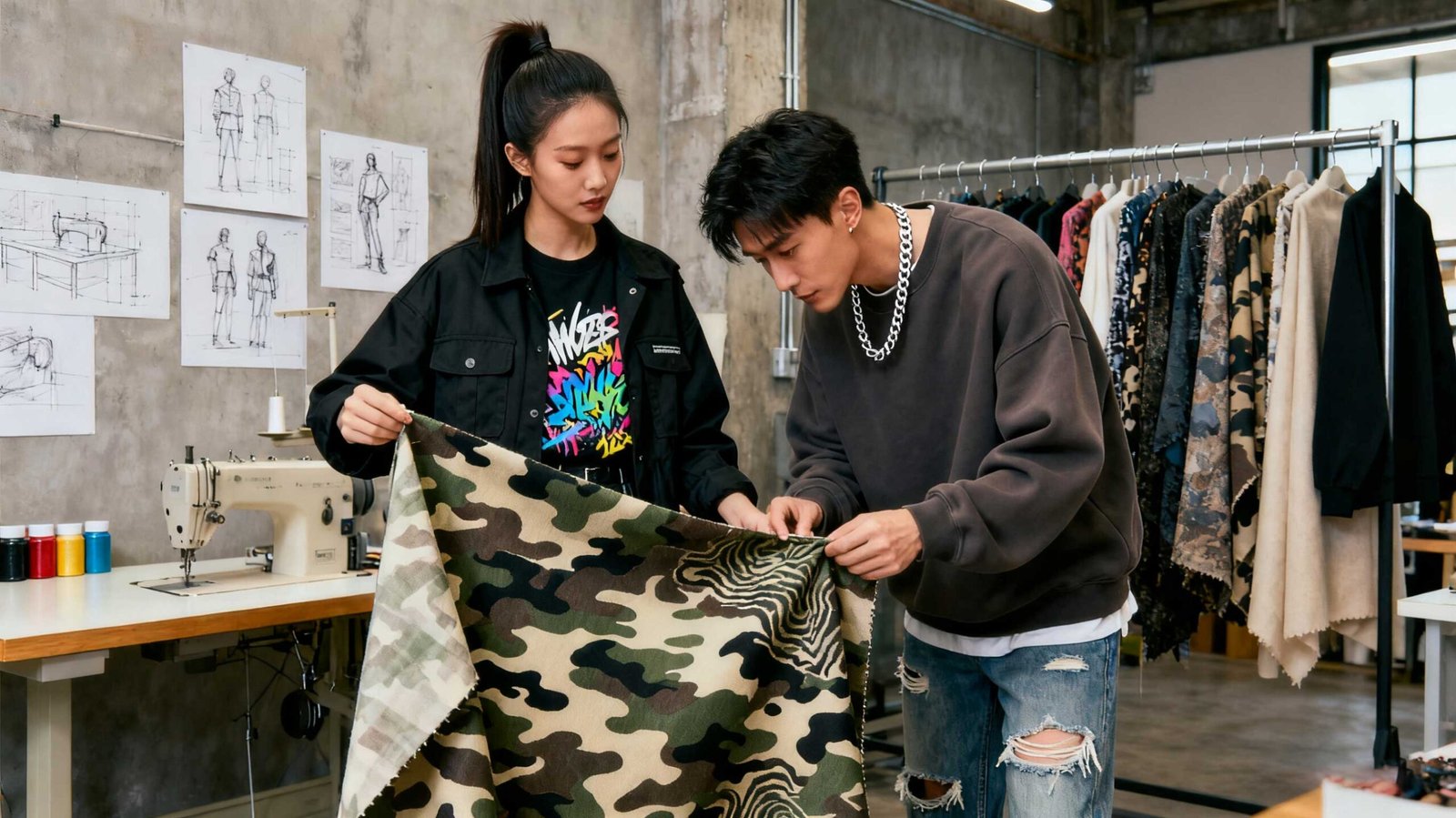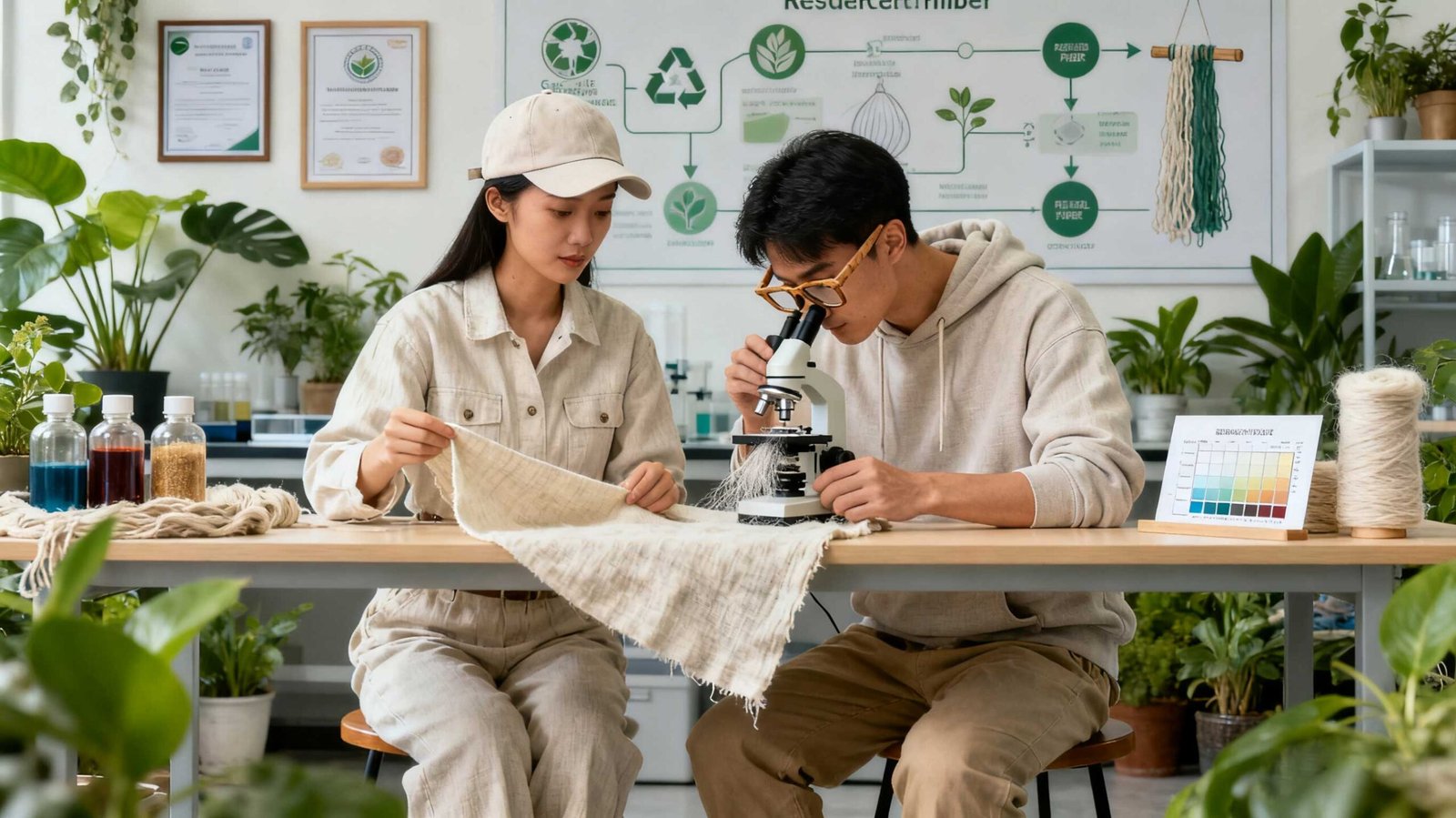Introduction
Breaking into the streetwear industry comes with a major hurdle: balancing quality production with limited startup capital. New designers often face impossible choices between compromising their vision or taking on excessive financial risk with high minimum orders.
This is precisely why China has become the go-to manufacturing hub for ambitious streetwear labels. The country's evolving production ecosystem now offers the ride-or-die combination that emerging brands need – low minimum order quantities (MOQs) that don't sacrifice quality or customization. Whether you're launching a limited-run hoodie collection or testing market response to graphic tees, Chinese manufacturers provide the flexibility to start small while maintaining the authentic streetwear aesthetic that trend-conscious consumers demand.
By partnering with established Chinese manufacturing facilities equipped with advanced technology, new streetwear brands can navigate the delicate balance between creative vision and production realities. This guide explores how to leverage China's manufacturing capabilities to bring your streetwear concepts to life – from finding reliable partners and optimizing costs to accelerating your speed to market in an industry where timing can make or break your brand's success.
The Rise of Streetwear and China's Manufacturing Advantage
The global streetwear market has exploded in recent years, transforming from underground cultural movement to mainstream fashion phenomenon. With its distinct blend of casual comfort, urban aesthetics, and limited-edition appeal, streetwear has captured the imagination of consumers worldwide. Behind this boom lies a manufacturing powerhouse – China – whose unique advantages have made it the go-to destination for streetwear production at every scale.
"China's manufacturing ecosystem offers streetwear brands unparalleled access to low minimum order quantities, advanced technical capabilities, and cost-effective production solutions that enable creativity without compromise."
The Global Streetwear Boom: Trends and Cultural Relevance
Streetwear has become a "big deal" in fashion circles, generating billions in global sales annually. What began as niche subcultures in skating, hip-hop, and urban communities has evolved into a dominant fashion category. The appeal lies in its accessibility, authenticity, and cultural cachet – qualities that resonate deeply with younger consumers.
This market segment thrives on exclusivity and rapid release cycles. Successful streetwear brands drop limited collections frequently, creating a constant buzz and demand. This business model requires manufacturing partners who can deliver small batches quickly while maintaining quality standards – a perfect match for China's production capabilities.
Why China? Infrastructure, Expertise, and Cost Benefits
China's dominance in streetwear production China stems from several key advantages. The country has developed an interconnected ecosystem where fabrics, trims, printing, embroidery, and assembly facilities exist in close proximity, dramatically reducing production timelines. This infrastructure enables streetwear brands to move from concept to finished product in weeks instead of months.
Additionally, decades of experience manufacturing for global fashion brands has created a skilled workforce familiar with international quality standards. Chinese factories understand the technical requirements of streetwear – from perfect screen printing to precise stitching on heavyweight fabrics – ensuring consistent quality across production runs.
Low MOQ Manufacturing: Enabling Small Brands to Compete
Perhaps the most significant advantage for emerging designers is China's willingness to accommodate low minimum order quantities (MOQs). While many manufacturing regions require thousands of units per style, Chinese streetwear manufacturers offer MOQs as low as 50-100 pieces per design, opening doors for independent creators.
| Production Factor | China Advantage | European Manufacturing | US Manufacturing | Impact on Brands |
|---|---|---|---|---|
| Minimum Order Quantity | 50-300 pieces | 500-1000 pieces | 300-800 pieces | Lower capital requirements |
| Production Lead Time | 15-30 days | 30-60 days | 25-45 days | Faster market response |
| Average Cost (T-shirt) | $4-8 | $12-20 | $10-18 | Higher profit margins |
| Technical Capabilities | Comprehensive | Limited | Moderate | Greater design flexibility |
| Scaling Capacity | Unlimited | Constrained | Moderate | Growth without changing vendors |
This low-barrier entry point allows new designers to test concepts with minimal financial risk. For those wondering how to start a streetwear brand in China, this advantage cannot be overstated – it democratizes fashion entrepreneurship in ways previously impossible.
Case Study: How Dec Garment Supports Emerging Labels
Dec Garment exemplifies the ideal streetwear production partner in China. With specialized expertise in hoodies, tees, and other streetwear staples, they've helped numerous independent brands launch successful collections. Their approach combines technical knowledge with flexibility – accommodating both small test runs and scaled production as brands grow.
By offering comprehensive services from fabric sourcing to packaging, manufacturers like Dec enable founders to focus on design and marketing rather than production logistics. This partnership model has proven especially valuable for international entrepreneurs navigating China's manufacturing landscape from abroad.
The combination of low MOQs, technical excellence, and end-to-end service creates a pathway for emerging streetwear brands to compete alongside established players – an opportunity that simply doesn't exist in most other manufacturing regions.
Selecting Reliable Streetwear Manufacturers in China
Finding the right manufacturing partner can make or break a streetwear brand. As streetwear production in China continues to dominate the global fashion landscape, emerging designers face the challenging task of identifying reliable factories among thousands of options. The right partner doesn't just produce garments—they become an extension of your creative vision and business operations.
"Successful streetwear brands prioritize manufacturing partnerships that combine technical expertise with cultural understanding, ensuring products resonate with target audiences while meeting quality standards."
Key Criteria for Choosing a Manufacturer: Experience, Certifications, and Technology
When evaluating streetwear manufacturers China offers, look beyond basic production capabilities. Experience with similar brands provides invaluable insights into your specific market segment. Established manufacturers like Dec Garment demonstrate their expertise through past collaborations and sample collections that showcase technical proficiency with streetwear-specific techniques.
Certifications matter significantly in today's conscious consumer environment. Legitimate manufacturers maintain ISO standards, BSCI compliance, and other ethical manufacturing certifications. These credentials verify not just ethical practices but also systematic quality management—crucial for consistent production across multiple collections.
Advanced technology separates "top-shelf" manufacturers from basic production houses. German cutting machines, automated stitching, digital printing equipment, and specialized finishing technology enable the precise execution of contemporary streetwear aesthetics, from oversized fits to complex graphics.
Evaluating Quality Control Processes in Chinese Factories
Quality control represents the backbone of successful custom clothing production in China. Reliable partners implement multi-stage inspection protocols rather than single end-product checks. This includes incoming material inspection, in-line quality monitoring, and comprehensive final inspections against approved samples.
| QC Stage | Industry Standard | Premium Manufacturer | Impact on Product | Verification Method |
|---|---|---|---|---|
| Material Inspection | Basic weight/color check | Comprehensive testing (shrinkage, colorfastness, composition) | Consistent fit, durability | Test reports, lab certifications |
| In-Line Inspection | Supervisor spot checks | Dedicated QC team at critical points | Fewer defects, consistent quality | QC reports, production photos |
| Final Inspection | AQL 2.5-4.0 | AQL 1.5-2.5 with detailed measurements | Higher customer satisfaction | Final inspection reports, measurement charts |
| Packaging Check | Basic visual inspection | Barcode verification, multi-point checks | Retail-ready presentation | Packaging guidelines, photos |
| Documentation | Basic production records | Digital tracking, detailed process documentation | Traceability, continuous improvement | Sample tracking system access |
Aligning with Urban Youth Culture Through Design Collaboration
The best partners for streetwear production understand youth cultural trends and can contribute meaningfully to design development. Look for manufacturers who actively engage in design feedback, material suggestions, and technical improvements rather than simply executing provided designs.
Effective collaboration requires manufacturers with dedicated design teams who can translate conceptual ideas into technical specifications. This collaborative approach is particularly valuable for brands seeking to implement best practices for streetwear production while maintaining their unique aesthetic vision.
Red Flags to Avoid: Common Pitfalls in Supplier Selection
Certain warning signs should immediately raise concerns when evaluating potential production partners. Be wary of manufacturers unwilling to provide physical samples of previous work or those reluctant to sign formal agreements protecting your intellectual property. Similarly, factories unable to provide client references or showing resistance to quality control protocols rarely deliver satisfactory results.
Communication issues during initial interactions often amplify during production. If basic correspondence proves challenging during sampling, expect significant difficulties when addressing production complications. The best manufacturers prioritize transparent communication channels with English-speaking staff dedicated to international clients.
Remember that unreasonably low pricing often indicates compromises in either materials or labor practices. Sustainable partnerships balance fair pricing with ethical production and appropriate profit margins for all stakeholders.
Customization and Sampling for Trend-Driven Streetwear
In the fast-moving world of streetwear, the ability to quickly transform creative concepts into tangible samples is crucial for brand success. Chinese manufacturing has revolutionized this process, offering unprecedented customization options paired with rapid sampling capabilities. This combination empowers emerging designers to test, refine, and launch collections that resonate with their target audience while minimizing financial risk.
"The strategic advantage of streetwear production in China lies in its unique combination of extensive customization options and accelerated sampling processes, allowing brands to validate concepts before committing to full production runs."
Customization Options: Fabrics, Prints, and Branding Elements
The breadth of customization available through custom clothing production China offers is unmatched globally. Beyond basic color and sizing variations, manufacturers provide access to specialized fabric treatments, innovative textile blends, and proprietary finishing techniques that create distinctive product identities.
Print customization represents a particularly strong advantage in the streetwear segment. Advanced facilities offer diverse decoration methods including discharge printing, puff prints, foil applications, and photorealistic sublimation—techniques that define contemporary streetwear aesthetics. These capabilities allow brands to create signature looks without the limitations typically imposed by less specialized manufacturers.
Branding elements extend beyond standard labels to include custom zipper pulls, woven badges, silicone applications, and specialized packaging. These details, while seemingly minor, significantly enhance perceived value and brand recognition in the competitive streetwear market.
The Role of Rapid Sampling in Market Testing
Perhaps the most significant advantage of working with a low MOQ streetwear manufacturer is the ability to produce small-batch samples for market validation. This approach has become "game-changing" for independent brands operating with limited capital.
| Sampling Type | Traditional Timeline | China Timeline | Cost Comparison | Business Impact |
|---|---|---|---|---|
| Development Sample | 3-4 weeks | 7-10 days | $150-300 vs. $80-150 | Faster design iteration |
| Fit Sample | 2-3 weeks | 5-7 days | $120-250 vs. $60-120 | Quicker size refinement |
| Salesman Sample | 3-5 weeks | 10-14 days | $200-400 vs. $100-200 | Earlier buyer presentations |
| Marketing Sample | 2-4 weeks | 7-10 days | $150-300 vs. $70-150 | Accelerated promotion cycle |
| Pre-Production Run | 4-6 weeks | 2-3 weeks | 30-50% higher elsewhere | Market testing before full investment |
This rapid sampling capability allows brands to test multiple design iterations, gathering customer feedback before committing to full production. The result is more market-aligned collections and significantly reduced financial risk—a critical advantage for streetwear labels operating in volatile trend environments.
Collaborating with Manufacturers for Authentic Streetwear Aesthetics
Successful streetwear production in China depends on effective creative collaboration between brands and manufacturing partners. The best manufacturers act as technical consultants, helping translate design concepts into production-ready specifications while preserving the brand's authentic voice.
This collaboration typically involves material substitution suggestions, construction modifications for improved durability, and production-friendly alternatives that maintain design integrity. Manufacturers with streetwear expertise can anticipate challenges specific to the category, such as achieving proper drape in oversized silhouettes or ensuring graphic durability on performance fabrics.
Balancing Creativity with Production Feasibility
One of the key benefits of sourcing streetwear from China is the ability to execute complex designs within commercial constraints. Experienced manufacturers help brands navigate the balance between creative expression and production practicality—identifying which customizations deliver maximum impact at manageable costs.
This guidance proves particularly valuable for emerging designers without technical production backgrounds. By providing clarity on cost implications, production timelines, and scalability considerations, manufacturers enable more informed decision-making throughout the design process.
The combination of customization flexibility, rapid sampling, and production expertise creates a powerful ecosystem for streetwear innovation. Brands that leverage these advantages can respond more nimbly to market trends while maintaining their distinctive aesthetic vision—a crucial capability in the fast-evolving streetwear landscape.
Sustainable Practices in Streetwear Production
As environmental awareness grows among consumers, sustainability has evolved from a niche concern to a mainstream demand in fashion. This shift is particularly pronounced in streetwear, where younger demographics are driving expectations for ethical production. Forward-thinking streetwear manufacturers in China are responding by implementing eco-conscious practices that balance environmental responsibility with the practical realities of production costs and scale requirements.
"The future of streetwear lies in brands that successfully merge authentic street culture with verifiable sustainability practices, creating products that resonate with increasingly conscious consumers."
Eco-Friendly Materials: Organic Cotton, Recycled Polyester, and More
Material selection represents the foundation of sustainable streetwear production China initiatives. Progressive manufacturers now offer expanded eco-friendly fabric options including GOTS-certified organic cotton, recycled polyester derived from post-consumer plastic bottles, and innovative alternatives like hemp blends and Tencel lyocell. These materials significantly reduce environmental impact while maintaining the performance characteristics essential for streetwear.
Beyond primary fabrics, sustainability extends to components and trims. Recycled polyester threads, natural corozo buttons, water-based adhesives, and biodegradable packaging materials collectively reduce a garment's ecological footprint. Leading manufacturers provide comprehensive material libraries that help brands make informed decisions about environmental trade-offs in their designs.
Water conservation technologies are becoming increasingly important in sustainable manufacturing. Advanced dyeing processes that reduce water consumption by up to 80% compared to traditional methods represent one of the most "clutch" innovations in eco-friendly production, especially for water-intensive cotton garments common in streetwear collections.
Ethical Manufacturing: Labor Standards and Transparency
Environmental sustainability cannot be separated from ethical labor practices. Reputable streetwear manufacturers maintain comprehensive worker welfare programs including fair compensation, reasonable working hours, safe facilities, and professional development opportunities. These standards are increasingly documented through transparent supply chain reporting accessible to brand partners.
| Sustainability Factor | Traditional Manufacturing | Emerging Standard | Industry Best Practice | Consumer Impact |
|---|---|---|---|---|
| Water Usage (per t-shirt) | 2,700 liters | 1,200 liters | 300-500 liters | Lower environmental footprint |
| Carbon Emissions | 5.5kg CO₂e per garment | 3.2kg CO₂e per garment | 1.5kg CO₂e per garment | Reduced climate impact |
| Chemical Management | Basic REACH compliance | ZDHC adherence | Closed-loop systems | Safer products, reduced pollution |
| Worker Compensation | Legal minimum wage | Living wage initiatives | Living wage + benefits | Ethical consumption alignment |
| Waste Management | 30-40% landfill | 10-20% landfill | <5% to landfill | Circular economy support |
Certifications to Look for in Sustainable Suppliers
Third-party certifications provide crucial verification of sustainability claims. When evaluating potential manufacturing partners, brands should prioritize facilities with recognized credentials like GOTS (Global Organic Textile Standard), GRS (Global Recycled Standard), Bluesign, and OEKO-TEX Standard 100. These certifications validate material authenticity and production processes.
Social compliance certifications such as WRAP (Worldwide Responsible Accredited Production), SA8000, and BSCI verify ethical labor practices. The most comprehensive manufacturers will maintain multiple certifications addressing both environmental and social aspects of production, demonstrating a holistic commitment to sustainability.
Balancing Sustainability with Cost and Scalability
One of the most significant trends in streetwear production involves finding the balance between sustainability ambitions and commercial realities. While eco-friendly materials typically increase costs by 15-30% compared to conventional alternatives, innovative manufacturers are developing strategies to mitigate these premiums through process efficiencies.
Scalability presents another critical consideration. Truly sustainable production systems must function effectively at various volumes, enabling brands to grow without abandoning their environmental commitments. Manufacturers investing in adaptable production technologies can maintain sustainability standards from small test runs to full-scale production.
For emerging streetwear brands, partnering with manufacturers that offer graduated sustainability options allows for progressive implementation aligned with business growth. This phased approach enables brands to incorporate eco-friendly elements strategically while building the pricing structure and consumer education needed to support fully sustainable collections.
Scaling Your Streetwear Brand with Chinese Manufacturers
For emerging streetwear labels, the journey from startup to established brand involves navigating crucial production transitions. The initial appeal of low MOQ production eventually gives way to the challenges of scaling efficiently while maintaining product integrity and profitability. China's manufacturing ecosystem offers unique advantages for brands ready to expand, providing infrastructure specifically designed to support growth at every stage.
"Successful scaling in streetwear production requires manufacturers with both the technical capacity to handle increased volumes and the flexibility to adapt as your brand evolves through different growth phases."
Transitioning from Low MOQs to Larger Production Runs
The path from small batch production to higher volume manufacturing represents a critical juncture for growing streetwear brands. The best low MOQ streetwear manufacturer partners anticipate this transition, offering graduated capacity increases that align with your brand's organic growth rather than forcing premature production jumps.
This scaling journey typically begins with test orders of 50-100 units per style, progressing to mid-level runs of 300-500 pieces, and eventually reaching full production capabilities of 1,000+ units. Each stage requires adjustments to quality control protocols, production planning, and resource allocation to maintain consistent product standards.
Strategic manufacturers implement standardized processes that remain consistent regardless of order volume, ensuring your tenth production run delivers the same quality as your first. This consistency becomes "money in the bank" for building customer loyalty during rapid growth phases.
Optimizing Supply Chain Logistics for Global Markets
As production volumes increase, efficient fashion supply chain China management becomes increasingly crucial for maintaining competitive pricing and reliable delivery. Scaling brands benefit from manufacturers with established logistics networks that offer consolidated shipping, customs facilitation, and inventory management solutions.
| Scale Factor | Startup Phase | Growth Phase | Established Phase | Optimization Strategy |
|---|---|---|---|---|
| Production Volume | 50-200 units/style | 300-1,000 units/style | 1,000+ units/style | Gradual capacity increase |
| Lead Time | 30-45 days | 25-35 days | 20-30 days | Production process refinement |
| Unit Cost Reduction | Baseline | 10-15% lower | 20-30% lower | Material consolidation, process efficiency |
| Quality Control | 100% inspection | AQL-based sampling | Statistical process control | Automated quality monitoring systems |
| Inventory Management | On-demand production | Partial forecasting | Just-in-time production | Integrated inventory monitoring |
Advanced streetwear production China facilities offer direct integration with e-commerce platforms and fulfillment centers, streamlining the flow from production to customer delivery. This integration becomes increasingly valuable as brands expand into multiple international markets with varying compliance requirements and delivery expectations.
Cost Management: Balancing Quality and Profit Margins
Scaling introduces opportunities for significant cost efficiencies without sacrificing product quality. Experienced manufacturers help brands identify strategic cost optimization through material consolidation, construction standardization, and production timing adjustments that preserve brand integrity while improving margins.
Volume-based pricing tiers typically emerge at key thresholds: 300, 500, 1,000, and 3,000 units. Working with manufacturers to understand these breakpoints allows brands to structure their collections and ordering strategies to maximize cost advantages while maintaining appropriate inventory levels.
Building Long-Term Partnerships with Manufacturers
For those learning how to start a streetwear brand in China, understanding the value of manufacturer relationships proves crucial to long-term success. The most productive partnerships evolve beyond transactional ordering to collaborative business development, with manufacturers contributing to product innovation and market expansion strategies.
Formalizing these relationships through preferential capacity agreements, graduated pricing structures, and collaborative development processes creates mutual investment in success. Manufacturers become true growth partners, proactively suggesting improvements and allocating resources to support your brand's trajectory.
The transition from startup to established brand relies heavily on selecting manufacturing partners with both current capabilities and future capacity. The right manufacturers grow alongside your brand, adapting their services to meet evolving needs while maintaining the product quality and brand ethos that drove your initial success.
Conclusion
After working with countless streetwear brands at different growth stages, I've seen firsthand how China's manufacturing ecosystem has democratized the entire industry. The combination of low MOQs, technical capabilities, and scaling potential creates a runway that simply doesn't exist elsewhere.
What makes Chinese production particularly valuable for emerging streetwear brands is the flexibility to start small without compromising on quality or customization. You can test the market with limited pieces, refine your designs based on real customer feedback, and scale production as demand grows – all with the same manufacturing partner.
Whether you're launching your first collection or expanding an established label, finding the right production partner in China is a "ride-or-die" decision that will shape your brand's trajectory. The streetwear landscape moves quickly, but with the right manufacturing support, you'll have the agility to stay ahead of trends while building a brand that stands the test of time.
FAQ
-
Q1: What are the best streetwear manufacturers in China?
A1: Some of the leading streetwear manufacturers in China include TUOZHEN, ATI China, and JCEE Fashion. These companies offer low minimum order quantities and high-quality customization options for brands.
-
Q2: How can I start a streetwear brand in China?
A2: To start a streetwear brand in China, research local manufacturers, establish a clear brand identity, design your products, and market them through social media channels. Collaborating with local influencers can also enhance visibility.
-
Q3: What is the typical MOQ for streetwear production in China?
A3: The typical minimum order quantity (MOQ) for streetwear production in China varies by manufacturer but generally starts around 50 to 100 pieces per style or color.
-
Q4: What trends are currently shaping streetwear production in China?
A4: Current trends in streetwear production in China include sustainable practices, the use of biodegradable materials, and AI-driven designs that predict fashion trends.
-
Q5: What are the benefits of sourcing streetwear from China?
A5: Sourcing streetwear from China offers benefits like cost-effectiveness, access to a wide range of materials, and experienced manufacturing capabilities, allowing for quick production and scalability.
-
Q6: How do I ensure quality when producing streetwear in China?
A6: To ensure quality in streetwear production, collaborate closely with manufacturers, conduct regular quality checks, and request samples before placing bulk orders.
-
Q7: What regulations should I be aware of when manufacturing streetwear in China?
A7: When manufacturing in China, brands should be aware of compliance with local labor laws, environmental regulations, and quality control standards applicable to textiles and apparel.
-
Q8: Are there ethical concerns associated with streetwear production in China?
A8: Yes, ethical concerns include working conditions in factories and environmental impact. Brands should perform due diligence and partner with manufacturers who follow ethical labor practices and sustainability.
External Links
- Streetwear Manufacturer in China - Craft Your Unique Style
- Streetwear Manufacturer China - Apparel & Textile Innovations
- List Of Streetwear Manufacturers in China - Uniway Sourcing
- 10 Innovative Trends Reshaping Streetwear Production in China 2025
- Inside China's Burgeoning Streetwear Scene | BoF - The Business of Fashion
- A New Era for China's $15 Billion Streetwear Market
- China's Streetwear Market Boom: Guide for Fashion Brands
- Streetwear in China: A Cultural Fusion with Unique Flair - Daxue Consulting




